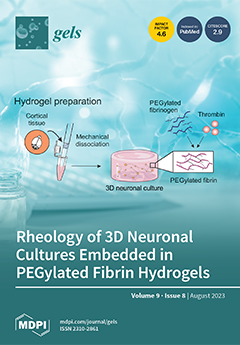Bacterial cellulose (BC) is a natural polysaccharide polymer hydrogel produced sustainably by the strain
Gluconacetobacter hansenii under static conditions. Due to their biocompatibility, easy functionalization, and necessary physicochemical and mechanical properties, BC nanocomposites are attracting interest in therapeutic applications. In this study, we
[...] Read more.
Bacterial cellulose (BC) is a natural polysaccharide polymer hydrogel produced sustainably by the strain
Gluconacetobacter hansenii under static conditions. Due to their biocompatibility, easy functionalization, and necessary physicochemical and mechanical properties, BC nanocomposites are attracting interest in therapeutic applications. In this study, we functionalized BC hydrogel with polydopamine (PDA) without toxic crosslinkers and used it in skin tissue engineering. The BC nanofibers in the hydrogel had a thickness of 77.8 ± 20.3 nm, and they could be used to produce hydrophilic, adhesive, and cytocompatible composite biomaterials for skin tissue engineering applications using PDA. Characterization techniques, namely Fourier-transform infrared spectroscopy (FTIR), X-ray diffraction (XRD), field emission scanning electron microscopy (FE-SEM), and Raman spectroscopy, were performed to investigate the formation of polydopamine on the BC nanofibers. The XRD peaks for BC occur at 2θ = 14.65°, 16.69°, and 22.39°, which correspond to the planes of (100), (010), and (110) of cellulose type Iα. Raman spectroscopy confirmed the formation of PDA, as indicated by the presence of bands corresponding to the vibration of aromatic rings and aliphatic C–C and C–O stretching at 1336 and 1567 cm
−1, respectively. FTIR confirmed the presence of peaks corresponding to PDA and BC in the BC/PDA hydrogel scaffolds at 3673, 3348, 2900, and 1052 cm
−1, indicating the successful interaction of PDA with BC nanofibers, which was further corroborated by the SEM images. The tensile strength, swelling ratio, degradation, and surface wettability characteristics of the composite BC biomaterials were also investigated. The BC/PDA hydrogels with PDA-functionalized BC nanofibers demonstrated excellent tensile strength and water-wetting ability while maintaining the stability of the BC fibers. The enhanced cytocompatibility of the BC/PDA hydrogels was studied using the PrestoBlue assay. Culturing murine NIH/3T3 fibroblasts on BC/PDA hydrogels showed higher metabolic activity and enhanced proliferation. Additionally, it improved cell viability when using BC/PDA hydrogels. Thus, these BC/PDA composite biomaterials can be used as biocompatible natural alternatives to synthetic substitutes for skin tissue engineering and wound-dressing applications.
Full article






